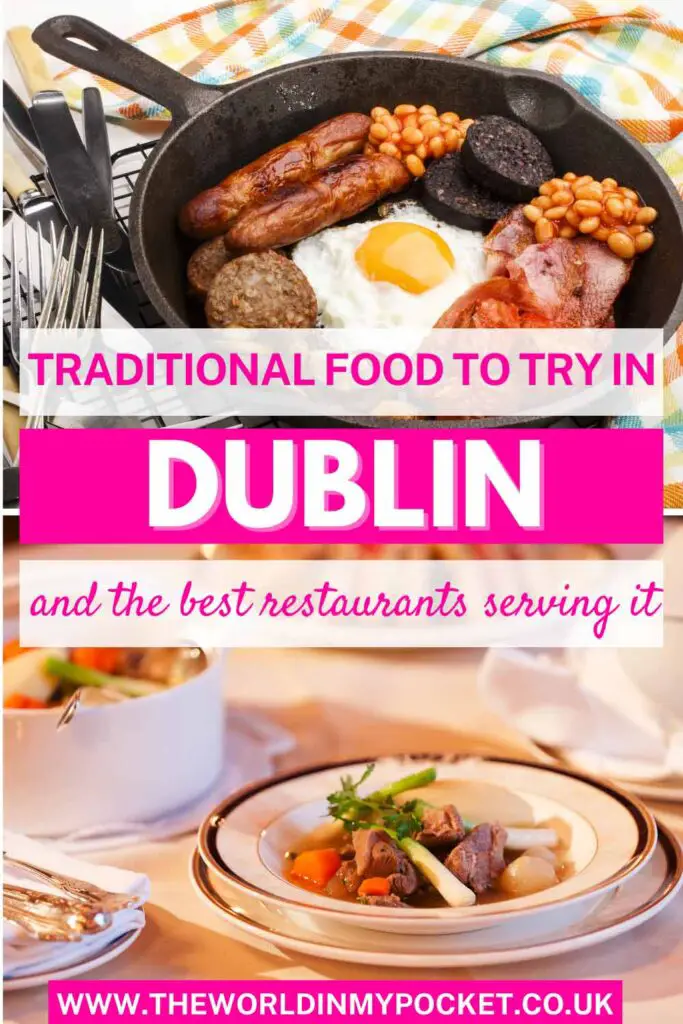Heading to Dublin soon and don’t have a clue where or what to eat? Don’t worry; we’ve all been there before.
Dublin is filled with some amazing restaurants serving the finest dishes of Irish cuisine. Because the food quality is 5 stars, you’re guaranteed a good meal no matter where you go. In this post, I’m going to give you the full breakdown of eating in Dublin, from the best restaurants to what to eat; by the end of reading this, you’ll know exactly how to fill your belly, Dublin style. Let’s go.
The Restaurants In Dublin

There are plenty of options when it comes to restaurants in Dublin. Some are overpriced, but there’s still a great chance you can find good value for your money when eating out. I have a few useful rules I stick by when choosing where to eat. Here they are.
- Never eat in a restaurant where there’s nobody sitting down. It’s sometimes a sign that the food isn’t great.
- If there are no prices on the menu, get out of there. You could end up with a bill that you weren’t expecting.
- Always read online reviews before going out to eat. Don’t pay for poor food.
- Avoid eating in touristy areas. The food quality usually isn’t great, and it’s overpriced.
- Ask the locals where to eat. They know the best eateries.
Eating in Dublin

If there’s one thing that Dublin does right, it’s food. When eating out, you’re spoiled for choice. You can find every cuisine under the sun in the Irish capital if you look hard enough. Malaysian, Greek, Lebanese—you name it.
The further you are from the city centre, the more likely you’ll find an affordable meal. Now, that’s not to take away from the odd fancy restaurant in the area that it’s known for. Finding affordable places to eat in the city isn’t unheard of; you just have to do a little bit of searching for them because they are there.
The Cuisine in Dublin

To understand the cuisine in Dublin, we have to go all the way back to the dark period of the Irish famine. For those of you who don’t know, in the 19th century, the country was highly dependent on potatoes, and out of nowhere came a potato blight that killed around about 1 million people due to the country’s dependence on them. Irish meals were and still are, to some extent, heavily potato-based. That Irish stereotype about all the Irish eating potatoes has some legs. Of course, we don’t eat potatoes with every meal, but we do enjoy one or two.
Let me provide you with the best meals in Dublin’s cuisine.
What To Eat in Dublin
A Slice Of Barmbrack

Barmbrack, sometimes confused with Christmas cake, is a type of bread filled with dried fruits and a dash of spice. It’s usually cut into slices and then buttered to one’s preference. Around Halloween, Irish mothers love to make a batch and pass it out to children trick-or-treating. The recipe dates back to the ancient Celtic festival of Samhain, when Celts believed that the mysterious souls of their ancestors appeared to them on the night. And still to this day, the famous brack is made in homes around Dublin. There’s a little tradition that’s still followed where the person cooking the brack will throw a ring in the mix, and whoever gets the piece with it on the inside, is destined to have good luck. Finding somewhere that sells this delicacy can be difficult, as it’s not made throughout the year. If you’d like to try some, I’d recommend you visit Dublin during the Halloween season and go to a bakery. They usually bake some around then.
A Carvery In A Local Pub

You’ll often hear Irish people say they’d murder a Sunday dinner. It’s a common saying that’s thrown around once Friday comes in Dublin. When they say Sunday dinner, they’re referring to a carvery, which is a plate filled up with freshly cut beef, mashed potatoes, sliced carrots, broccoli, a couple of roasted potatoes, one or two Yorkshire puddings, a pile of stuffing, and all of it either covered with gravy or peppered sauce. I can tell you this traditional meal is well and truly alive and served almost every Sunday in most Irish homes. On a Sunday afternoon, the dish is available in a number of Dublin pubs. When the person who cooks the Sunday dinner is too tired, the family usually heads down to a local pub that serves it. There are plenty of pubs across Dublin that I’d recommend you check out, but one that always comes to mind is the gastropub called the Coachman’s Inn beside Dublin Airport. Pop in and have one before you take off on your flight to head home.
Beef And Guinness Pie

A good, hearty beef and Guinness pie is something that everyone should experience at least once in their life. The recipe takes everything that’s in an Irish stew, such as chopped beef, onions, and celery, beef stock, gravy, and a drop of Guinness, and then it’s added to a warm, crispy pastry made in the oven. For added flavour, some cooks like to add a tiny drop of mustard. A warm beef and Guinness pie is traditionally served with Guinness, Ireland’s famous stout. Many Irish bars around the world are known to serve the dish, so if you can’t make it to Dublin, you can still try it if you’re interested. It may not be exactly like it’s served in Ireland, but it’s still definitely worth trying. When in Dublin, make your way to the Hairy Lemon for the best beef and Guinness pie.
A Full Irish Breakfast

There’s no better meal to wake up to than an Irish breakfast. The dish isn’t exactly healthy, but it’s delicious. It contains toast, baked beans, pork sausage, rashers (bacon), hash browns, fried mushrooms, fried eggs, and white and black pudding. It’s a vegetarian’s greasy nightmare.
You can find places all over the city centre serving a full Irish breakfast in the morning. Check out the Lemon Jelly Cafe for the best one in town.
A Dublin Coddle

Did you really visit Dublin if you didn’t have a coddle? Coddle is a dish that you either love or hate. It’s made from fresh spuds, sausages, sliced onions, chunky bits of bacon, and beef stock. A lot of people usually eat it when it’s cold outside. Irish mothers enjoy serving it to their children to keep them warm. For a delicious coddle, head over to Gravediggers. They’re also known for serving the best pint of Guinness in Dublin.
A Chicken Fillet Roll

If you’ve never heard of a chicken fillet roll, you’re in for a treat. This tasty hangover treat is simply a doughy bread roll saturated with some butter and a lump of succulent fried chicken cut into pieces. You’ll have the option to add some fillings, such as lettuce or some crispy bacon. It’s not difficult to obtain one of these bad boys, as they’re available at most petrol stations and corner shops around the capital. To make your first time trying a chicken fillet roll that little bit more enjoyable, grab a nice, strong cup of Barry’s Tea. You won’t be disappointed.
A Warm Bowl Of Irish Stew

A typical dish served in every home in Dublin is a piping-hot bowl of stew. The dish was originally something that people who never had any money ate back in the 1800s, as large portions could be cooked up for an affordable price. Your typical Irish stew contains sliced beef, parsley, potatoes, chopped onions, chopped carrots, bite-sized pieces of leek, shredded cabbage, and a tiny drop of Worcester sauce. Every chef’s recipe is different, you can use different meat or vegetables to cater to your taste. The Old Mill Restaurant is well known for its delicious stew, but if you have the opportunity, I’d recommend befriending a local and having their parents or, even better, grandparents, cook you some from scratch. There’s something special about having a stew in somebody’s home.
A Lump Of Colcannon

Colcannon is a popular dish traditionally made on St. Patrick’s Day, but many people make it all year long. The dish is quite simple to make; it’s simply mashed potatoes mixed with cabbage and butter. It’s normally served with a meat of choice, like beef or chicken. Some people like to substitute the cabbage with either kale or spinach, but the traditional way to do it is the one I’ve explained. Similar to Irish stew, it was a dish that was made by people who didn’t have much money back in the day, but it’s now popular among plenty of Dubliners. Gallaghers Boxty House is a great little spot near the Hapenney Bridge that serves a delicious colcannon, and they have a wide selection of Irish gin if you’re in the mood for one or two.
Like it? Pin it!

Disclaimer: Some of the links on this website are “affiliate links.” This means that if you click on the link and do a purchase, I will receive an affiliate commission at no extra cost for you. This helps me keep my website running and continue to share my travelling knowledge with you. I thank you for booking your flights or hotels using the links on my website. Regardless, I only recommend products or services I use personally and believe will add value to my readers.



My husband and I have a five block rule where we try to get that far away from the main tourist areas when looking for a place to eat. Usually you can begin to find where the locals like to eat.
We are heading to Dublin in the new year, so this post is super handy! Thanks for all the great recommendations!
I LOVED trying all the different foods in Dublin! That traditional breakfast is so filling too; a great way to start the day before exploring.
I’ve always wanted to visit Dublin for alcohol but this make me excited for the food too😂
the food looks very filling, perfect for cold days! I am a breakfast person so I am most interested in full breakkie, I am sure that would keep going for LONG! the beef pie sounds very attractive to me but I won’t lie really I would try it all!
Those rules for eating out- so true . How is Dublin for vegetarians? I love trying different cuisines but find that some places don’t offer as many choices to vegetarians as others.
It looks like there are lots of great places to eat in Dublin. Love your rules for choosing where to eat, the lack of prices on the menu likely meaning it will be over priced is a great tip.
I like your checklist for how to find a good place to eat. And there are some really yummy dishes here, I could do with a chicken fillet roll right now x